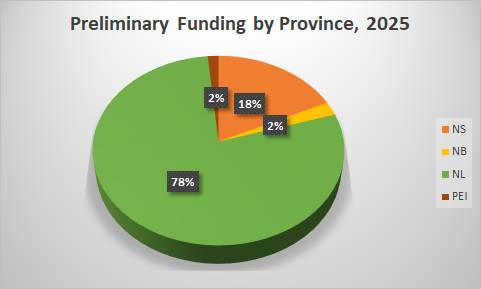New Brunswick’s venerable tech investor Gerry Pond often bemoans the fact that he can receive a tax incentive to invest in Arkansas but not in Nova Scotia.
The investment group that Pond chairs, East Valley Ventures, has a portfolio of 26 active companies, and Pond could have claimed New Brunswick’s Small Business Investor Tax Credit only on the 17 that are based in New Brunswick. His investments in Nova Scotia, Prince Edward Island and British Columbia would not have been eligible.
The problem is that the only real Canadian tax incentives to invest in startups are offered by provincial governments, and they apply only when both investor and the startup are based in the province that issues the credit.
Navdeep Bains, the federal Minister of Innovation, Science and Economic Development, needs to change this. The Minister is now devising “a bold, coordinated strategy on innovation” and the cornerstone should be a federal tax credit to encourage investment in innovative startups.
Canada cannot develop an innovative economy without startups. Pure research is essential for innovation, but innovation that stays in a lab has a limited economic impact. To truly diversify the economy, Canada needs companies that produce revolutionary products for industry and consumers. They will need tens of billions of dollars of investment, and a federal investment tax credit is the best way to ensure that investment.
Investment tax credits are now available in roughly seven provinces and 30 American states. They return to investors a percentage of the money they place in a new business up to a certain maximum. The New Brunswick program is probably the most generous in Canada, offering a credit of 50 percent on investments of up to $250,000.
But New Brunswick companies can only use the credit to attract investment from 750,000 New Brunswick residents. The British Columbia program only applies to BC residents. Ontario doesn’t have a program.
A federal tax credit would at least allow Canadian startups to draw investment from any Canadian taxpayer. I say “at least” because Ottawa could enhance the program by following the example of such states as Arkansas and Minnesota, which allow investors from outside the state to benefit from the tax credit.
The big worry about such a program is that it would be a drain on the Treasury, even though repeated studies (such as Thomas Hellman’s “An Evaluation of the Venture Capital Program in British Columbia” in 2010) have shown these tax credits actually increase tax revenue. A federal tax credit doesn’t have to be an open-ended drain on the Treasury. Like the B.C. program, the federal government could cap the program each year so it would only offer a certain amount of tax credits.
Read Our Latest Entrevestor Intelligence Report
Some also worry an investment tax credit would be viewed as a gift for the wealthy as moneyed investors would be the only ones to claim the credit. That argument ignores the fact that startups need capital and can only get it from people or institutions with capital. The message has to be that financing innovative companies is essential to our national goals, and the investment tax credit is the best way to do this. Members of cabinet know this is the case. Before he became Transport Minister, Marc Garneau said in 2013, “If the rich are encouraged to invest in Canada’s startups, then it will be worthwhile.”
There is now a splendid opportunity to bring in these tax credits because the best imaginable salesperson for such a policy is the current Prime Minister. Justin Trudeau gets innovation and is superb at discussing technology in ways that grab people’s attention. He also has the ear of many of the groups that would criticize an investment tax credit.
So what should the tax credit look like?
First off, the maximum allowable investment has to be $250,000 or higher, and each qualifying company should be able to apply the credit to investments up to $3 million per year. Hundreds of Canadian startups are now in their growth stages and need multi-million-dollar funding rounds. The investment strategy will fail if these companies need to find dozens of investors to raise meaningful money. The high threshold would also allow investors in smaller companies to benefit, so it would encourage startups of all sizes.
Second, the incentive should be offered to investors outside Canada. All Canadian governments spend gazillions attracting external investment, but are strangely reluctant to incentivize foreign investors to put money in our fastest-growing, domestic companies. By extending the credit to foreigners, investors from around the world would be encouraged to consider backing some of the great innovators in Canada.
Third, the government should work with provinces to reform their investment tax credits so they mesh with the new federal program. This could reduce the immediate cost to the federal treasury and amplify the power of the program in luring investment into innovation. It would also ensure the tax credits go to startups outside Montreal, Toronto and Vancouver.
One word of warning: the economic impact of this initiative will be blunted if the government tries to channel too much of the investment into renewable energy. The pressing need to end the use of fossil fuels is obvious. But the conversion to clean energy will require hundreds of billions of dollars in infrastructure changes. A tax credit for innovation isn’t the way to finance infrastructure. Our research at Entrevestor shows the greatest economic payback comes with investment in information technology. And given the collapse in resource prices, Canada needs investment in enterprises that will grow quickly.
So let’s say that the federal government awards a 30 percent tax credit, and will cut off the spigot after it awards, say, $2 billion of tax credits. And let’s say half the credits are awarded to people living outside Canada. What would the effect be if investors maxed out on the program?
First, the net hit to the federal treasury would be minimal, and it could even benefit the government’s coffers in the medium term. Second, it would mean an equity investment of $6.7 billion in the fastest growing segment of the Canadian economy. That would compare to the $2.3 billion invested by venture capital firms in Canada in 2015, according to Canada’s Venture Capital and Private Equity Association. It would be the most effective way possible to develop innovation in our economy.
Let’s emphasize again: Canadian startups need capital, especially at the scaling phase of their growth. The government should encourage private investment, even if it could be seen as a benefit to wealthy investors. This is the best way to generate jobs for young people and to diversify the Canadian economy.
A federal innovation tax credit would be the type of “bold” strategy that Minister Bains has so rightly called for.
This column has been adapted from the author’s submission to Minister Bains as he consults on the government’s innovation strategy.










